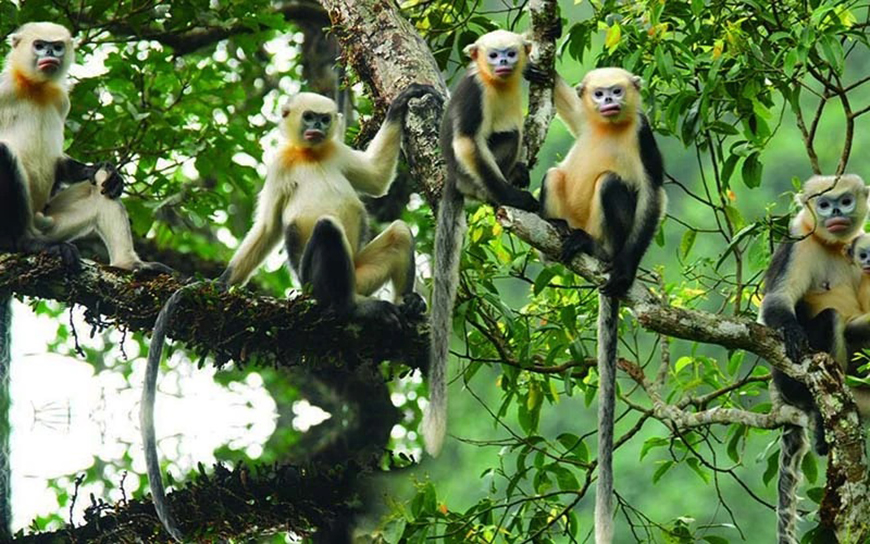Preamble
Imagine yourself in the heart of Ba Be National Park, nestled in the karst mountains of northern Vietnam. Morning mists rise above a turquoise lake, while the songs of exotic birds resonate in the dense canopy. Suddenly, a movement catches your attention: a group of snub-nosed langur gracefully swing from branch to branch, their long black fur contrasting with the lush greenery. This idyllic scene, witnessing a rich and diverse wildlife, is however threatened by an invisible peril: climate change.

The critically endangered Snub-nosed Langur - Source : Internet-DR
Timeout observing animals : a valuable tool for conservation
Extended observation of animals, an essential practice for understanding and conserving biodiversity, plays a crucial role in combating this scourge. By monitoring animal populations over long periods of time, scientists can document the impacts of climate change on their behavior, ecology, and distribution. This wealth of information allows for a better understanding of how species adapt to environmental changes and identifies those that are most vulnerable.
Brief presentation of Ba Be National Park
Established in 1992, Ba Be National Park is a biodiversity gem. Covering an area of 10,048 hectares, it hosts a unique karst ecosystem characterized by spectacular limestone formations and Vietnam's largest natural lake.
Home to over 1,000 plant species and 300 animal species, the park provides a refuge for exceptional wildlife. Among the park's gems is the black crested gibbon, a species threatened by deforestation and hunting. Thanks to extended observation, researchers have been able to better understand the habitat requirements of this primate and identify priority areas for its conservation.

The Black Capped Kingfisher of Ba Be - Source : Internet-DR
Faunal richness
As previously emphasized, the park's fauna is remarkably diverse, including 65 mammal species, several of which are endangered primates, 233 bird species - including the emblematic Edwards's Pheasant (Lophura edwardsi) on the brink of extinction - making the park a popular destination for ornithologists. Reptiles and amphibians are represented by 43 species, all adapted to aquatic and terrestrial environments. Finally, there are 106 fish species, some of which are endemic to Lake Ba Be.
Observing to better understand and act
Extended observation of animals is a valuable tool for understanding the impacts of climate change on fauna and identifying appropriate solutions. By tracking animal movements, scientists can determine the areas most affected by climate change and implement targeted conservation measures.
Scientific observation methods
Researchers use various techniques to study the park's fauna:
- 1. Line transects: To estimate the density of mammal and bird populations.
- 2. Camera traps: To document nocturnal or elusive species.
- 3. Telemetry: To track the movements of key species like the black crested gibbon.
- 4. Acoustic studies: To identify and monitor bird and bat populations.
These methods allow researchers, forest rangers, and tour guides to gather valuable data on animal behavior, ecology, and interactions in their natural habitat. This information is essential for wildlife conservation as it helps understand the vital needs of species, identify threats they face, and implement appropriate protection measures.

The emblematic White Cheeked Black Langur - Source : Internet-DR
Focus on the black crested gibbon (Trachypithecus francoisi)
This critically endangered primate is emblematic of the park. Extended observations have revealed:
- - Estimated population: Less than 200 individuals in the park.
- - Preferred habitat: High-canopy limestone forests.
- - Diet: Primarily folivorous, with a preference for young leaves.
- - Social behavior: Groups of 5 to 15 individuals, with one dominant male.
- - Main threats: Habitat fragmentation and poaching.
Impacts of climate change
Climate change poses a growing threat to the fauna of Ba Be National Park. Increasing temperatures, changes in precipitation patterns, and intensification of extreme weather events disrupt natural habitats and weaken animal populations. Species that depend on specific ecosystems, such as orchids and pollinating insects, are particularly vulnerable. Extended observation plays a crucial role in monitoring the impacts of climate change on wildlife and developing adaptation strategies for its conservation.
Furthermore, these impacts highlight several effects of climate change:
- 1. Modification of phenological cycles: Early flowering and fruiting disrupting food chains.
- 2. Altitudinal species shifting: Some birds now nest at higher altitudes.
- 3. Water stress: More frequent drought periods affecting vegetation and aquatic fauna.
- 4. Extreme weather events: Increased flooding and landslides.

The spectacular Great Hornbill - Source : Internet-DR
Adaptation and resilience
Researchers have observed adaptive responses in certain species:
- - The red-faced macaque (Macaca arctoides) expands its diet to include previously less consumed plant species.
- - Some amphibian species modify their breeding periods to adapt to new precipitation patterns.
Preserving wildlife for future generations
Conservation efforts in Ba Be National Park are based on data collected through prolonged animal observation. This data helps identify priority areas for conservation, establish population monitoring programs, and raise public awareness about the importance of protecting biodiversity. Educating local communities is also essential to ensure wildlife preservation. By integrating traditional knowledge and local practices into conservation efforts, it is possible to create a sustainable synergy for nature protection.
Conservation and public engagement
The park implements several initiatives to involve the public in conservation:
1. Responsible ecotourism programs: Guided wildlife observation with local naturalists.
2. Citizen science projects: Monitoring bird populations with the help of volunteers.
3. Environmental education: Workshops and exhibitions on the park's biodiversity and the threats of climate change.

Ba Be is home of the Kingfisher - Source : Internet-DR
Conclusion
Ba Be National Park, with its rich and diverse wildlife, is a priceless natural treasure. Timeout observing animals in Ba Be National Park provides us with a unique window into the complex dynamics between wildlife, the environment, and climate change. This knowledge is crucial for developing effective and tailored conservation strategies, ensuring the sustainability of this exceptional ecosystem for future generations.